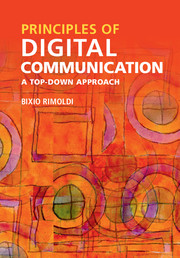[1] J. M., Wozencraft and I. M., Jacobs, Principles of Communication Engineering. New York: Wiley, 1965.
[2] R. G., Gallager, Principles of Digital Communication. New York: Cambridge University Press, 2008.
[3] A., Lapidoth, A Foundation in Digital Communication. New York: Cambridge University Press, 2009.
[4] J. F., Kurose and K. W., Ross, Computer Networking. New York: Addison Wesley, 2010.
[5] J., Gleick, The Information: A History, a Theory, a Flood. London: Fourth Estate, 2011.
[6] M., Vetterli, J., Kovačević, and V., Goyal, Foundations of Signal Processing. New York: Cambridge University Press, 2014.
[7] S., Ross, A First Course in Probability. New York: Macmillan & Co., 1994.
[8] W., Rudin, Real and Complex Analysis. New York: McGraw-Hill, 1966.
[9] T. M., Apostol, Mathematical Analysis. Reading, MA: Addison–Wesley, 2nd edn, 1974.
[10] S., Axler, Linear Algebra Done Right. New York: Springer-Verlag, 2nd edn, 1997.
[11] K., Hoffman and R., Kunze, Linear Algebra. Englewood Cliffs: Prentice-Hall, 2nd edn, 1971.
[12] R. A., Horn and C. R., Johnson, Matrix Analysis. Cambridge: Cambridge University Press, 1999.
[13] J. G., Proakis and M., Salehi, Communication Systems Engineering. Englewood Cliffs: Prentice-Hall, 1994.
[14] J. R., Barry, E. A., Lee, and D. G., Messerschmitt, Digital Communication. New York: Springer, 3rd edn, 2004.
[15] U., Madhow, Fundamentals of Digital Communication. New York: Cambridge University Press, 2008.
[16] S. G., Wilson, Digital Modulation and Coding. Englewood Cliffs: Prentice-Hall, 1996.
[17] D., Tse and P., Viswanath, Fundamentals of Wireless Communications. New York: Cambridge University Press, 2005.
[18] A., Goldsmith, Wireless Communication. New York: Cambridge University Press, 2005.
[19] T. M., Cover and J. A., Thomas, Elements of Information Theory. New York: Wiley, 2nd edn, 2006.
[20] R. G., Gallager, Information Theory and Reliable Communication. New York: Wiley, 1968.
[21] D., MacKay, Information Theory, Inference, and Learning Algorithms. New York: Cambridge University Press, 2003.
[22] S., Lin and D. J., Costello, Error Control Coding. Englewood Cliffs: Prentice-Hall, 2nd edn, 2004.
[23] T., Richardson and R., Urbanke, Modern Coding Theory. New York: Cambridge University Press, 2008.
[24] C., Shannon, “A mathematical theory of communication,” Bell System Tech. J., vol. 27, pp. 379–423 and 623–656, 1948.
[25] H., Nyquist, “Thermal agitation of electric charge in conductors,” Physical Review, vol. 32, pp. 110–113, July 1928.
[26] A. W., Love, “Comment: On the equivalent circuit of a receiving antenna,” IEEE Antenna's and Propagation Magazine, vol. 44, pp. 124–125, October 2001.
[27] D., Slepian, “On bandwidth,” Proceedings of the IEEE, vol. 64, pp. 292–300, March 1976.





